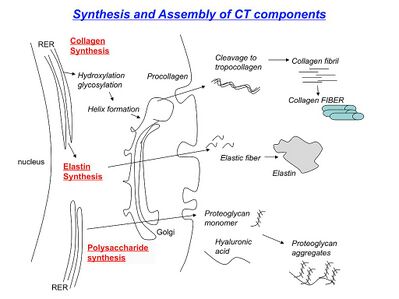Fibroblast: Difference between revisions
No edit summary |
No edit summary |
||
| Line 35: | Line 35: | ||
<references /> | <references /> | ||
[[Category:Physiology]] | |||
Revision as of 07:12, 26 June 2022
Original Editor - Lucinda hampton
Top Contributors - Lucinda hampton, Vidya Acharya and Kim Jackson
Introduction[edit | edit source]
Fibroblasts are the most common cell in connective tissue and connective tissues permanent residents. They secrete the fibers (notably collagen and elastin) and ground substance of the extracellular matrix.
Fibroblasts are often spindle-shaped with an elongated nucleus. When active fibroblasts are easily recognized by their abundant rough endoplasmic reticulum and prominent Golgi apparatus.[1]
Obtained from a person through a simple skin biopsy, fibroblasts can be grown in the laboratory for use in genetic and other scientific studies of that individual. In recent years, studies on reprogramming human fibroblasts into neurons or heart cells have emerged.Cite error: The opening <ref> tag is malformed or has a bad name
Fibroblasts are cells are diverse, participating in tissue homeostasis and disease by producing the complex extracellular matrix and creating signaling niches through biophysical and biochemical cues. These properties, when activated aberrantly, drive fibrotic disorders in humans.Cite error: The opening <ref> tag is malformed or has a bad name
Adaptability[edit | edit source]
Fibroblasts are known for their ability to change function. Adipocytes, pericytes, endothelial and epithelial cells can de-differentiate into fibroblasts. Stimulation of fibroblasts further increases vulnerability to epigenetic modifications. The ability of fibroblasts to transform is partly due to the variety of cell-surface adhesion receptors that facilitate the communication of fibroblasts with their surroundings. An example is the fibroblast transformation into the myofibroblast, essential in wound healing.[2]
Connective Tissue Repair[edit | edit source]
Connective tissue repair is carried out by new fibroblasts which are derived from cells called pericytes. Pericytes are embedded in the basement membrane of blood capillaries These new fibroblasts then migrate into wounds, following injury, and helping repair the damage.[3] Contractile fibroblasts, called myofibroblasts are also often generated, and these help to contract wounds.
Terminology and More[edit | edit source]
- Fibroblast: Synthetically active state
- Fybrocyte: Synthetically inactive state
- Tenoblast: specialised fibroblast
- Osteoblast: specialised fibroblast
- Myofibroblasts: contractile fibroblasts, having contractile properties, play a critical part in wound healing.
- Cardiac fibroblast: a cell that produces connective tissue (in contrast to the connective tissue of bone and tendon, which is organized into regular patterns of collagen, heart ECM is dense, irregular, and composed of collagens, proteoglycans, and glycoproteins)[4]
- Reticular cell: type of fibroblast that synthesizes collagen alpha-1(III) and uses it to produce reticular fibers. Eg Reticular cells provide structural support, producing and maintaining the thin networks of fibres, that are a framework for most lymphoid organs. [5]
- Bone marrow fibroblasts regulate hematopoiesis by interacting directly (cell-to-cell contact) with hematopoietic cells and by secreting regulatory molecules that have a positive or negative effect.[6]
References[edit | edit source]
- ↑ Histology Guide Fibroblast Available: https://histologyguide.com//EM-view/EM-006-fibroblast/03-photo-1.html (accessed 26.6.2022)
- ↑ Dick MK, Miao JH, Limaiem F. Histology, Fibroblast. [Updated 2022 May 8]. In: StatPearls [Internet]. Treasure Island (FL): StatPearls Publishing; 2022 Jan Available:https://www.ncbi.nlm.nih.gov/books/NBK541065/ (accessed 26.6.2022)
- ↑ Histology Leeds Fibroblasts Available: https://www.histology.leeds.ac.uk/tissue_types/connective/connective_tissue_fibros.php (accessed 26.6.2022)
- ↑ Malina J. Ivey, Michelle D. Tallquist, Defining the Cardiac Fibroblast, Circulation Journal, 2016, Volume 80, Issue 11, Pages 2269-2276, Released on J-STAGE October 25, 2016, Advance online publication October 14, 2016, Online ISSN 1347-4820, Print ISSN 1346-9843, https://doi.org/10.1253/circj.CJ-16-1003, https://www.jstage.jst.go.jp/article/circj/80/11/80_CJ-16-1003/_article/-char/en,
- ↑ Britannica Reticular cells Available:https://www.britannica.com/science/reticular-cell (accessed 26.6.2022)
- ↑ Rougier F, Dupuis F, Denizot Y. Human bone marrow fibroblasts--an overview of their characterization, proliferation and inflammatory mediator production. Hematol Cell Ther. 1996 Jul;38(3):241-6. doi: 10.1007/s00282-996-0241-3. PMID: 8974787.







